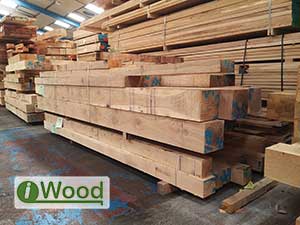Articles: Tidying up your Oak Beams
What to expect with your oak beams
Oak is a sensational product, one of the most aesthetic pieces of timber with some of the most durable properties.
Oak beams can be used as exposed timber or for decorative purposes and will create class and sophistication wherever they are used.

Overtime Oak beams change, and their aesthetics move from the typical golden appearance with a small amount of splits and cracks to an aged silver grey appearance with many splits and cracks.
Something to consider with oak beams is that they are often supplied fresh sawn and cut straight from the log in large production facilities. These freshly cut beams go through various handling and processing before being used as an end product.
It's not uncommon for fresh sawn beams to exhibit surface level imperfections such as blue stain, water stain and grain furring.
Don't panic! This is normal and easily rectifiable with a bit of DIY or a little bit of maintenance from your builder who is more than likely already prepared for the task.
See below for what you can do.
DIY Sandblasting beams
I'm sure you've came across this suggestion whilst researching oak beams and how to look after them. Sandblasting oak beams will make quick work of these small imperfections.
The general working practice behind sandblasting oak beams is tiny particles are pressurized and sprayed onto the beam to strip away the surface layer of timber.
There are other methods such as oxalic acid cleaning, or having the beams completely planed which are both effective solutions but lack a degree of flexibility that sandblasting offers.
Oxalic acid crystals are used to remove surface level markings left over from handling and are simple and cheap to use.
They do not however remove any physical imperfections like scuffs and dents.
Planing is the opposite end of the spectrum where the entire top layer of timber is sliced off with a machine planer removing 6mm of timber from each face. The result is a very even surface and uniform texture but ofcourse you remove a good amount of timber.
Sandblasting is in the middle of the two, you get the benefits of not removing so much material but also the ability to remove imperfections that are a few mm rather than the full 6mm from planing.
You can also use a sandblaster on existing timber to clean it up. As mentioned above, overtime, Oak and other timbers will begin to change in appearance. Sandblasting can remove some of those changes by gently sanding them off.
Sanding Oak beams

When it comes to oak beam finishes, there are alot of options out there to create a luxury aesthetic.
One of the most popular methods is to get hold of a hand sander to create a smooth finish and then add treatment to preserve the initial appearance of the beams.
However, when ordering fresh sawn oak, you may find that you may get some subtle furring up of the beams, this will occur even on a planed beam.
This is normal and you can sand it back to a smooth finish, overtime however, oak will always age the same way and the typical weathered look will creep through.
Is there a difference in appearance between English Oak and European Oak?
English oak beams are grown in a similar climate to their European cousin so you'll be hard pushed to find a difference between the two.
That being said, English Oak is steeped in rich history and when buying English Oak you know it's grown right here in the UK. Subsequently contributing to the growth of British industry and the local economy. Additionally you're helping create jobs in forest management and reducing the UK's carbon footprint both of which helps the sustainability of the timber sector and the preservation of our planet.







 Main Menu
Main Menu

